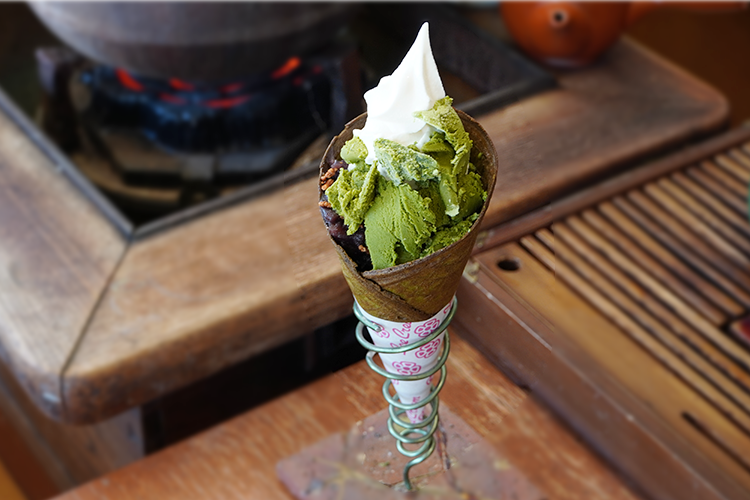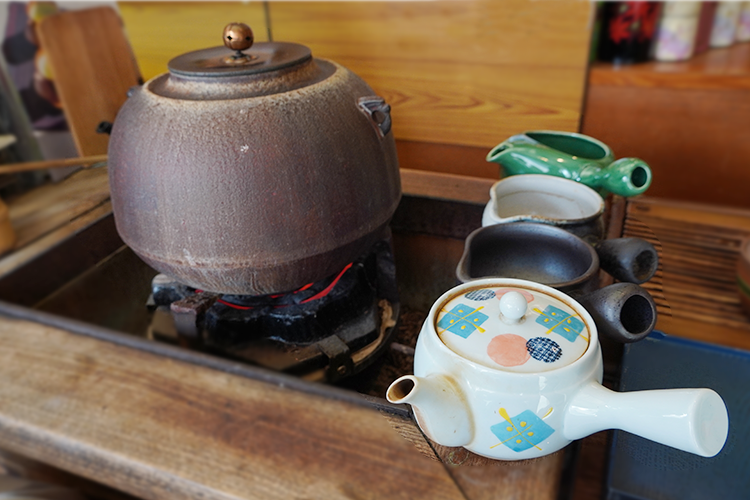ReservationSearch and reserve rooms
Click here to confirm, change or cancel your reservation
提携法人専用予約
2024.06.30
"Gyokusuien Tea" pursues "what only a northern tea wholesaler can do"
NEIGHBORS

The Sousei River runs through the center of Sapporo. The area to the east of the river is also called Sousei East, and while it still retains an atmosphere reminiscent of the pioneering days, it has also seen the emergence of many unique restaurants and other establishments, and is garnering attention as an area where the charms of old and new blend together.
Located in one corner of the park is Gyokusuien Tea, a long-established store with over 90 years of history that started out as a wholesaler specializing in Japanese tea, mainly from Uji and Shizuoka.
We explored the background behind their journey as a tea wholesaler that continues to convey the charm of tea as professionals, and what they can do as a tea shop in the north.
A wholesaler specializing in Japanese tea that supports business in Sapporo

Gyokusuien around 1953. The company later built a new head office building and took on its current appearance.
Gyokusuien was established as a Japanese tea specialty store in 1933 (Showa 8). On either side of the Sosei River, wholesalers and residential buildings were located on the east side, while retail stores such as Marui and Mitsukoshi were located on the west side, and Gyokusuien is said to have played a role in supporting the commercial area on the west side.
Nowadays, boxes loaded with tea can be transported by train or car, but back then, road conditions were not good and it was difficult to transport boxes weighing up to 40 kilograms each by horse-drawn carriage or sled.
The founder, Mr. Tamaki, decided to set up his store at Minami 1-jo Higashi 1-chome 1-banchi, close to the river, due to the characteristics of the Sousei area and the presence of Naebo Station further east, which was developing as a logistics hub.

"He probably thought that this would become the center of Sapporo when he set up shop, but my grandfather was an incredibly visionary man. He was like a psychic (laughs). I'm sure he was also blessed with friends who taught him all kinds of things."
Welcoming us with a smile, we were greeted by the third-generation owner, Tamaki Yasuo, who wears many hats including being a Japanese tea instructor and hunter.
The founder, Mr. Tamaki, was originally from the Kaga domain. He ended up moving to Hokkaido, where development was progressing, and began to search for "what he could do to make a viable business in the future."
"In Hokkaido, things that could be produced locally could be obtained not only through buying and selling, but also through barter. That's why they thought, 'We should sell things that are difficult to produce locally,' and they started buying and selling tea."
Establishing the "Gyokusuien" taste by refining blending techniques

You can enjoy the different flavors each time you brew it, from the first brew to the second brew to the third brew.
"If we just buy and sell tea, we will soon lose out to others." Feeling a sense of crisis in continuing the business, they search for "something that only Gyokusuien can do." However, in the cold climate of Hokkaido, it is difficult to produce delicious tea...
What helped me break out of this situation was a certain comment from someone in Kyoto, where we were purchasing goods.
"If you want to create a unique flavor, you should hone your blending skills." "If you take advantage of Hokkaido's cold and dry conditions, you might be able to let the sake sit for a long time and let it mature."
Since then, the "long-term aging" process, which gives the sake a gentle, mellow yet rich flavor, and the "blending techniques" that allow for versatile flavors have been refined, resulting in the "unique Gyokusuien flavor." That spirit and technique have been passed down to Mr. Tamaki, the third-generation owner.
Protecting the forest means protecting the water

"Yukimomiji" roasted Ezo deer tea tsukudani, a perfect accompaniment to rice
Even after the baton was passed to the third generation, the challenges continue. One of these challenges is the "Mizu no Moribito Aged Tea," which was born from an aging experiment in the "Hoheikyo Rim Tunnel," which protects Sapporo's water.
In recent years, the number of Ezo deer has increased, and Tamaki-san learned that the forests are being destroyed. He obtained a hunting license and began to travel deep into the mountains. He then developed a tsukudani called "Yuki Momiji" by simmering the meat of the deer he had hunted in roasted green tea. "Hunting and consumption" is also a way to protect the forests and waters.
"My grandfather told me, 'If we want to pass on the tradition to the next generation for another 100 years, we need to preserve the flavor of the tea, but the other important thing is water. To do that, we need to nurture forests.'"
It is said that these words have become the family motto of the Tamaki family.
Enjoy the deliciousness of Hokkaido ingredients

"Yukimoe Parfait (Deluxe Hand-baked Matcha Cone)" is an original dessert only available at "Gyokusuien". It is so popular that some people visit twice a day. As it is produced in small quantities, it may be sold out.
Gyokusuien, which values and protects the natural environment, has an eat-in space inside the store where you can enjoy your favorite Japanese tea, as well as original sweets such as the "Yukimoe Parfait" and ochazuke made with "Snow Maple Leaf."
Among them, the "Yukimoe Parfait" is a highly popular menu item that evokes the contrast of the pure white snow that falls on the northern land, the light green color of the new leaves that represent the transition from spring to summer, and the fruitful autumn and earth, giving you a taste of the bountiful Hokkaido.
By combining high-quality ingredients from Hokkaido, such as milk and bean paste from Tokachi, long-aged matcha, brown rice, and hand-baked matcha cones, with the traditional techniques of a northern tea wholesaler, we have created a refined, slightly bitter, and refreshing taste that you will never get tired of.
The background to the creation of the parfait was the reality that "excess milk is being wasted due to excessive production." After pondering "what can we do as a tea shop to address the issues surrounding food," we arrived at the idea of "making the most of Hokkaido's finest ingredients."
The important "relationship with food" for tea shops

The original Hokkaido-aged green tea "Mizu no Moribito Japan Ruby" was served at the reception of the G7 Energy and Environment Ministers' Meeting held in Sapporo on April 15, 2023. It goes perfectly with meat dishes.
This unique imagination for combining food and tea is something that Tamaki-san has been cultivating since he was a child. He would travel by plane and bullet train to restaurants all over Japan, and sometimes the chefs would teach him the basics of cooking.
"Just because we're a tea shop doesn't mean we only have to study tea. The relationship with food is actually very important for a tea shop."
Eating a variety of foods and knowing their tastes means having knowledge backed by real-life experiences. Only then can you suggest necessary and useful items to customers when they ask.
Cherish the connections that continue beyond the things we do

"When we start something, whether it's Ezo deer, milk, parfaits, or tea, we think about the lives of the people who produce it."
"If we only think about ourselves, we end up thinking, 'if it stops selling, we can just stop.' But I don't think my grandfather would have wanted that kind of relationship. I hope we can continue moving forward without changing the style of human relationships that my grandfather started," says Tamaki, taking a great deal of time to explain.
While enjoying your meal, whether you eat in or take out, feel free to ask any questions you may have. You're sure to hear many stories that will make you want to know more about the store's history and the profound depth of tea.
お茶の玉翠園(ぎょくすいえん)
電話番号:011-231-1500
住所:北海道札幌市中央区南1条東1丁目1−1 玉木ビル
アクセス:地下鉄「大通駅」より徒歩3分程度
HP:https://gyokusuien.co.jp/
SNS:https://www.instagram.com/gyokusuien_sapporo/
*営業時間や定休日についての詳細は、上記のリンク先にてご確認ください。



